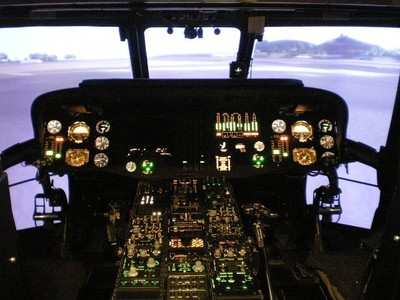Wed, Feb 16, 2011
Full-Mission TOFT Sim For Pilots And Co-Pilots
Naval Aviation Training Systems program office (PMA-205)
delivered a SH-60B Seahawk Tactical Operational Flight Trainer
(TOFT) to Marine Corps Base Hawaii (MCBH), in late 2010. "With the
new TOFT on location, the crews have more simulation time affording
proficiency in mission readiness while staying close to home, thus
eliminating cost associated with flying crews to the mainland."
said Capt. John Feeney, Naval Aviation Training Systems program
manager, PMA-205.

Previously, aircrews from Helicopter Anti-Submarine Squadron
Light THIRTY-SEVEN (HSL-37) homeported at MCBH would travel to
Naval Air Station North Island, CA, for simulation training. The
TOFT, built by CAE, Tampa, FL, includes both an operational flight
trainer (OFT) and a weapons tactics trainer (WTT) that can operate
independently or jointly. It is housed in the newly constructed
John K. Koelsch building.
The flight trainer is a full-mission simulator used to train
pilots and co-pilots. It includes motion seats that provide
vibrations and motion onset cues, and a Mylar window visual display
used with operational night vision goggles. It also includes full
mission and weapons system simulation. The weapons trainer
replicates the back-end of the helicopter and is used to train
sensor operators and airborne tactics officers. It features
detailed simulations of underwater and atmospheric environments, as
well as the aircraft weapons and sensors to prepare crew members
for anti-submarine and anti-surface warfare missions.

When the OFT and WTT are used jointly they become a TOFT,
designed to provide total aircrew mission training. Operating in
this mode, the pilot and co-pilot in the OFT and the sensor
operator in the WTT can interact in the training scenario the same
way they will during an actual submarine hunt or surface warfare
mission. "We are excited to have the device here at Kaneohe Bay
[MCBH]. Not only is our own squadron utilizing the simulator, the
forward deployed squadron HSL-51 [Helicopter Anti-Submarine
Squadron Light FIFTY-ONE from Naval Air Facility Atsugi, Japan]
also uses the trainer to assist crews in combat simulation," said
Alan Jones, Aircrew Simulation Systems manager.
The SH-60B Seahawk is a multi-mission helicopter used for
anti-submarine warfare and surface attack, as well as search and
rescue, vertical replenishment and medical evacuation.
More News
A Puff Of Smoke Came Out From The Top Of The Engine Cowling Followed By A Total Loss Of Engine Power On May 9, 2025, about 1020 mountain daylight time, an experimental amateur-buil>[...]
From 2022 (YouTube Edition): Jenny, I’ve Got Your Number... Among the magnificent antique aircraft on display at EAA’s AirVenture 2022 was a 1918 Curtiss Jenny painstak>[...]
Very High Frequency (VHF) The frequency band between 30 and 300 MHz. Portions of this band, 108 to 118 MHz, are used for certain NAVAIDs; 118 to 136 MHz are used for civil air/grou>[...]
“From approximately November 2021 through January 2022, Britton-Harr, acting on behalf of AeroVanti, entered into lease-purchase agreements for five Piaggio-manufactured airc>[...]
Microburst A small downburst with outbursts of damaging winds extending 2.5 miles or less. In spite of its small horizontal scale, an intense microburst could induce wind speeds as>[...]
 NTSB Prelim: Lee Aviation LLC JA30 SuperStol
NTSB Prelim: Lee Aviation LLC JA30 SuperStol Classic Aero-TV: Curtiss Jenny Build Wows AirVenture Crowds
Classic Aero-TV: Curtiss Jenny Build Wows AirVenture Crowds ANN's Daily Aero-Term (05.30.25): Very High Frequency (VHF)
ANN's Daily Aero-Term (05.30.25): Very High Frequency (VHF) Aero-News: Quote of the Day (05.30.25)
Aero-News: Quote of the Day (05.30.25) ANN's Daily Aero-Term (05.31.25): Microburst
ANN's Daily Aero-Term (05.31.25): Microburst




